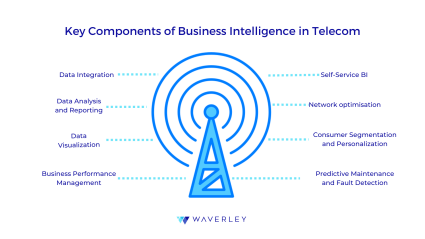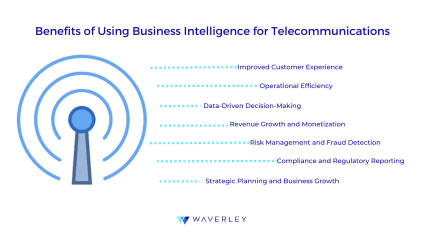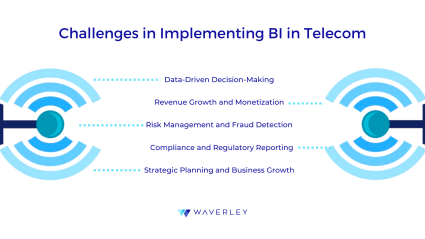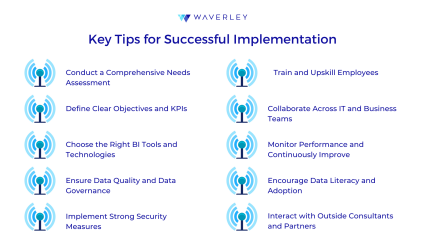BI in Telecom Industry: Tips for Successful Implementation

Contents
Considering the different ways of generating success and profit, companies are eager to take advantage of all the tools available to optimize internal operations and improve customer experiences. Some of these tools offer them to analyze their own data in order to get valuable insights and make informed strategic decisions. In this context, the role of business intelligence (BI) emerges as a cornerstone of success.
In the telecom industry, business intelligence acts as a beacon, bringing important insights from deep data streams to light. Telecom businesses can make educated decisions, optimize workflows, and seize new possibilities with the use of business intelligence (BI), which covers everything from customer behavior patterns to network performance measurements. It functions essentially as an organizational strategic compass, guiding them through the complex maze of contemporary telecommunications.
This article delves into the importance of business intelligence services in the telecommunications industry and examines its potential to transform operations and boost competitiveness. We will address important tactics for the effective execution of BI projects, enabling telecom companies to prosper in an increasingly dynamic market context, with an emphasis on providing practical guidance.
Understanding Business Intelligence in Telecom
Thus, some advantages of business analytics in the telecom industry include:
- Service Personalization: customer insights are useful for developing services and marketing strategies that are specifically catered to the demands, interests, and behaviors of customers.
- Resource Optimization: identification of inefficiencies in the network, maintenance planning, and more accurate resource allocation help organizations ensure operational efficiency.
- Informed decision-making: real-time data analytics in the form of charts and graphs enables intelligent, data-driven choices at all organizational levels.
Also, the telecom industry is greatly impacted by business intelligence (BI) at different organizational levels:
- Executives may watch key performance indicators (KPIs) for strategic planning, identify opportunities and hazards, and keep an eye on market trends.
- By analyzing operational data, middle managers can identify actual workflow bottlenecks and make specific interventions to improve process effectiveness.
- Front-office staff members use BI-derived actionable data to enhance customer interactions and provide individualized services.
By facilitating data processing, BI as a whole helps telecom companies make the most of their data assets. In a market where competition is fierce, it fosters innovation, improves operational effectiveness with proactive tactics, and provides decision-makers with useful information to enable data-driven decision making throughout the company.
Key Components of Business Intelligence in Telecom

Business intelligence (BI) in the telecom sector includes a range of components critical for efficiently utilizing data to support strategic decision-making and operational efficiency:
- Data Integration
Robust data integration methods are fundamental to the successful use of business intelligence by telecom companies. Telecom businesses handle large and varied datasets from multiple sources, such as customer contacts, network performance indicators, and market trends. Organizations may guarantee data accuracy, consistency, and accessibility by directing these various data sources into a single repository. This makes data analysis simple and enables well-informed choices for decision-makers at all organizational levels to make. - Data Analysis and Reporting
In telecom, data analysis and reporting allow companies to get useful insights from unprocessed data. Advanced analytical methods such as sentiment analysis, machine learning, and predictive modeling, help telecom operators find patterns, trends, and correlations in their data. Furthermore, customizable reporting functions, which provide real-time tracking of strategic objectives, business health, and important performance indicators, promote proactive management and flexible decision-making. - Data Visualization
Data visualization is essential for turning complicated statistics into insightful visual representations in the field of business intelligence. Visualizations like charts, graphs, and interactive dashboards provide telecom firms with a user-friendly interface for exploring and comprehending large amounts of data. Organizations may enhance their ability to communicate insights, promote data-driven discussions, and enable stakeholders to make well-informed decisions quickly by showcasing data in a visually appealing way. - Business Performance Management
Business performance management refers to the procedures, approaches, and tools used to track and improve the performance of a business. Setting strategic goals, identifying key performance indicators (KPIs), and regularly assessing performance in relation to these metrics are all part of this process in the telecom sector. Telecom operators may drive operational excellence and accomplish strategic objectives by using BI tools to receive real-time visibility into their company performance, pinpoint areas for improvement, and launch focused interventions. - Self-Service BI
Self-service BI gives employees across the company the ability to view and examine data on their own, without needing a lot of technical know-how or assistance from IT departments. Self-service BI technologies empower front-office employees, middle managers, and executives to independently examine data, explore insights, and make data-driven choices in the telecom industry, where speed and responsiveness are critical. In addition to quickening decision-making procedures, this democratization of data access encourages data-driven innovation and teamwork within the company. - Network optimization
Network optimization in telecom puts an emphasis on maximizing the effectiveness and performance of telecommunications networks. Telecom operators can improve network dependability and quality of service by using BI tools to monitor network traffic, pinpoint congestion areas, and optimize routing algorithms. Organizations can attain cost savings, enhance customer connectivity, and limit downtime by taking proactive measures to overcome network bottlenecks and capacity constraints. - Consumer Segmentation and Personalization
Business intelligence in the telecom industry also enables advanced consumer segmentation and personalization. Through the analysis of use, behavioral, and demographic data, telecom companies are able to divide their client base into discrete groups based on shared attributes and preferences. This makes it possible to create customized product offerings, focused marketing strategies, and unique consumer experiences. BI solutions also make dynamic segmentation easier. This allows businesses to react instantly to shifting consumer demands and market conditions, eventually increasing client happiness and loyalty. - Predictive Maintenance and Fault Detection
These two business intelligence uses in the telecommunications industry enable telecom operators to anticipate possible equipment problems before they happen by utilizing machine learning algorithms, historical performance data, and telemetry data from network equipment. Proactive maintenance eliminates interruptions to service provision, decreases downtime, and increases the life of network infrastructure. Furthermore, real-time detection of abnormalities in network performance indicators by BI tools allows for quick issue resolution and reaction, maintaining uninterrupted service delivery and raising customer satisfaction.
Benefits of Using Business Intelligence for Telecommunications

Business intelligence offers a multitude of benefits that promote performance and innovation, boosting the success and competitiveness of telecommunications companies.
Let’s consider these benefits in more detail.
- Improved Customer Experience
Telecom companies may obtain profound insights into the needs, tastes, and behaviors of their customers thanks to BI. Using BI can increase customer happiness and loyalty by personalizing services, anticipating their needs, and providing seamless experiences through the analysis of large datasets. - Operational Efficiency
BI streamlines operational procedures in various service domains, including customer support and network administration. Telecom firms may boost productivity, cut costs, and improve service delivery by optimizing workflows, finding inefficiencies, and allocating resources wisely. - Data-Driven Decision-Making
Using real-time data and predictive analytics, business intelligence enables telecom managers and executives to make well-informed decisions. Organizations like Amazon Redshift may enhance their competitiveness and agility by promptly responding to market trends, seizing opportunities, and reducing risks by utilizing actionable insights. - Revenue Growth and Monetization
Telecom firms can find ways to generate money and improve their pricing strategies with the help of business intelligence. Through the examination of consumer behavior patterns, industry trends, and their competitors, businesses can create customized products, efficiently cross- and upsell, and optimize income sources. - Risk Management and Fraud Detection
When it comes to detecting and reducing risks, such as fraud and security breaches, business intelligence is essential. Telecom operators can identify suspicious activity in real-time, averting financial losses and protecting their reputation, by keeping an eye on abnormalities in usage patterns, transactional data, and network activity. - Compliance and Regulatory Reporting
BI solutions make it easier for companies to adhere to industry norms and legal regulations. Telecom firms can minimize compliance risks, uphold stakeholder confidence, and assure adherence to regulatory duties by automating data collection, analysis, and reporting operations. - Strategic Planning and Business Growth
Business growth strategies and strategic planning benefit greatly from the help that BI offers. Organizations can position themselves for long-term success and sustainability by identifying growth possibilities, effectively allocating resources, and fostering innovation through the advanced analysis of market trends, competitive landscapes, and consumer feedback.
Challenges in Implementing BI in Telecom

Just like in any other industry on its way to innovation, in addition to the numerous benefits, the telecom sector also faces certain obstacles when implementing business intelligence solutions, including organizational, cultural, and technological ones. In this section, we reveal some typical difficulties telecom businesses run into when embracing BI and ways to deal with them.
- Lack of Skills and Required Training
For BI to be implemented in telecom organizations, specific knowledge of data analytics, data modeling, and data visualization is frequently needed. Unfortunately, finding, keeping, and upskilling employees with the required knowledge can be difficult for many firms. Spending money on certification programs, employee training programs, and talent development activities is necessary to close the skills gap and meet training needs. This will ensure that the workforce is qualified to fully utilize BI solutions. - Scalability Issues
When it comes to BI deployment, scalability becomes a major challenge as telecom businesses manage enormous volumes of data generated from network operations, customer contacts, and market activity. The velocity, diversity, and volume of data may be too much for traditional BI systems to handle, which could result in latency problems, performance bottlenecks, and higher infrastructure expenses. To overcome this, telecom businesses must make investments in distributed computing technologies, cloud-based services, and scalable BI architectures that can handle increasing data volumes and enable agile analytics at scale. - Difficult Regulatory Framework
The telecom sector works in a complex regulatory framework with strict guidelines for data security, privacy, and compliance. To maintain data security, privacy, and legal compliance, BI implementation must abide by regulatory criteria, such as GDPR, HIPAA, or industry-specific regulations. To avoid regulatory risks and assure ethical data practices, navigating regulatory intricacies needs meticulous preparation, strong data governance structures, and cooperation with legal and compliance teams. - Problems with Data Integration
Combining data from various sources, including billing records, market data, network performance measurements, and client data, is a common challenge for telecom businesses. These data sources could be located in several departments, systems, or formats, which could cause problems with data quality, redundancy, and inconsistency. To ensure smooth data flow and accuracy across the company, overcoming data integration difficulties calls for strong data governance procedures, standardized data formats, and interoperable technologies. - Cultural Barriers to Adoption
One of the biggest obstacles to the deployment of business intelligence (BI) in telecom organizations is cultural aversion to change. Workers may be reluctant to embrace BI tools and processes because they are used to conventional decision-making procedures or because they are dubious about the usefulness of data-driven insights. Strong leadership, clear communication, and organizational change management techniques can break down cultural barriers promoting a data-driven culture, increasing employee trust in BI tools, and enabling workers to embrace data-driven decision-making as a fundamental skill.
Key Tips for Successful Implementation

Now, that we’ve discussed the role of Business Intelligence for the Telecom sector, it’s high time we started talking about the actual steps needed for implementing BI solutions in this vertical, including the development and integration of OSS and BSS software. From setting specific goals to interacting with outside partners, the below pointers offer helpful direction for BI projects that succeed.
1. Conduct a Comprehensive Needs Assessment
It is critical to start by carrying out a comprehensive analysis of the business needs, obstacles, and possibilities your company has. Determine important stakeholders, get feedback from cross-functional teams, and rank all the revealed aspects according to their viability and business impact.
2. Define Clear Objectives and KPIs
The next step is to clearly define the goals and key performance indicators (KPIs) that align with your business objectives. Set quantifiable goals for the use of business intelligence, such as raising operational effectiveness, decreasing attrition, or enhancing customer happiness.
3. Choose the Right BI Tools and Technologies
Choose BI technologies and tools that will complement your organization’s technological infrastructure, financial constraints, and needs. Such BI instruments may include, for instance:
- Platforms for self-service analytics (such as Tableau and Power BI).
- Tools for data visualization (such as Qlik and Domo).
- Software for predictive analytics (such as SAS and IBM Watson Analytics).
- Cloud-based BI programs (like Google Cloud and AWS).
4. Ensure Data Quality and Data Governance
Make a significant investment in data quality management procedures and set up strong data governance structures to guarantee the precision, coherence, and integrity of your information. Adopt data validation, standardization, and cleansing processes to ensure high-quality and relevant results on the outcome.
5. Implement Strong Security Measures
Take care of data security and privacy by putting strong security measures in place to safeguard sensitive data. To avoid unwanted access or breaches, encrypt data both in transit and at rest, set up user authentication procedures and access controls, and routinely audit and monitor data access.
6. Train and Upskill Employees
Offer thorough training and upskilling initiatives to equip staff members with the abilities needed to utilize BI tools and technologies efficiently. Provide practical training, workshops, and certification courses to develop a workforce that understands data and can use BI insights to make decisions.
7. Collaborate Across IT and Business Teams
To guarantee that technical capabilities and commercial objectives are in line, encourage cooperation and communication between IT and business departments. Encourage strong collaboration amongst cross-functional teams at every stage of the BI implementation process, from gathering requirements to deployment and beyond.
8. Monitor Performance and Continuously Improve
Create performance-tracking systems to measure the return on investment and efficacy of your business intelligence endeavors. Keep an eye on important metrics like report usage, user adoption rates, and KPI accomplishments. Utilize feedback loops to pinpoint areas that require optimization and improvement. To ensure continued success, tweak and adapt your BI strategy frequently in light of new information and lessons discovered.
9. Encourage Data Literacy and Adoption
Encourage data-driven decision making at all levels of your organization to create a culture of data literacy and adoption. By emphasizing the advantages of BI tools and technologies, creating user-friendly interfaces, and providing continuing support and resources, employers can encourage staff members to adopt them. Reward accomplishments and honor individuals or groups that use BI insights to produce favorable results, highlighting the significance of data-driven activities.
10. Interact with Outside Consultants and Partners
Utilize the experience of BI services providers and consultants to enhance internal resources and hasten the deployment of business intelligence. Work together with consultants, specialized suppliers, or industry professionals who have used BI solutions in the telecoms sector. Form strategic alliances to gain access to industry benchmarks, best practices, and state-of-the-art innovations that can improve the efficacy and efficiency of your business intelligence operations. By utilizing outside expertise, telecom firms may maximize the return on investment from their BI projects, reduce implementation risks, and obtain insightful knowledge.
Best Practices for Sustaining Business Intelligence Initiatives
Business intelligence (BI) projects must be proactive and committed to continuously generating value from data in order to be self-sustained and evolve over time. Here, we provide some hands-on recommendations for keeping your telecom BI initiatives up and running.
- Regularly review and update BI strategies to align with your business goals.
To make sure your BI strategies are in line with your current priorities and business goals, it is crucial to regularly examine and update them. As market dynamics and business objectives change over time, it’s a business-critical task to evaluate the success of current BI initiatives, spot new trends and possibilities, modify your BI roadmap as necessary, and hold strategic planning meetings. Your business intelligence (BI) initiatives will continue to be relevant and effective if you maintain flexibility and responsiveness to evolving company needs. - Foster data-driven culture within the organization.
Long-term BI initiative success depends on fostering a corresponding corporate culture. Encourage staff members at all levels to adopt data-driven decision making by giving them access to tools and training, emphasizing the importance of data-driven insights, and praising and rewarding those who use data wisely. Encourage a collaborative atmosphere where data is integrated into daily operations and decision-making processes and seen as a strategic asset. - Continuously monitor and optimize BI processes for performance improvements.
To sustain performance and promote ongoing improvements, BI procedures must be regularly monitored and optimized. Set up key performance indicators (KPIs) for your BI instruments, such as report accuracy, data latency, user adoption rates, and ROI to monitor the success and efficiency of business intelligence (BI) activities. To find areas for improvement and bottlenecks in your BI system, use data analytics and performance monitoring technologies. To increase the efficacy and value of your BI initiatives over time, implement incremental upgrades and optimizations based on user input, best practices, and insights from data analysis.
Use Cases Of Telecom Business Intelligence
In this section, we show you real-world examples, highlighting the benefits of business intelligence and lessons learned from these implementations.
| Company | Case Study | Benefits | Lessons learned |
|---|---|---|---|
| Vodafone | One of the biggest telecom firms in the world deployed a complete business intelligence system to boost productivity and enhance customer experience. |
|
|
| AT&T | Leading telecom provider AT&T implemented cutting-edge business intelligence tools to improve customer service and network performance. |
|
|
| Telefonica | Headquartered in Spain, Telefónica is an international telecommunications firm that has optimized network performance, enhanced customer service, and increased operational efficiency through the implementation of modern business intelligence solutions. |
|
|
| Verizon Communications | Verizon, one of the top telecom providers in the US, upgraded network performance and customer service by putting in place a strong business intelligence platform. |
|
|
| China Mobile | In terms of the number of subscribers, China Mobile is the biggest telecoms firm in the world. They applied BI solutions to improve customer experience, optimize resource allocation, and boost network performance. |
|
|
How Waverley Can Help
As a BI service provider, Waverley has expertise in creating complex data analytics solutions and consulting for large organizations in the telecom sector, as well as other industries. We provide the know-how on data aggregation, data preparation and processing, data visualization, live dashboard implementation, report generation, and more to help companies boost their profits using data wisely.
The team of Waverley Software are also experts in telecom software development, having addressed the demands and challenges of top telecom firms, such as Matrixx and Sicap. Experience with projects in this field helps us to better understand industry specifics and make use of internal cross-team collaboration to get practical recommendations for our BI solution developers.
In addition to technical competence and skilled software engineers, we pay great attention to rigorous business research and efficient project management. Due to our collaborative agile approach along with proactive communication and unwavering dedication to excellence, we manage to successfully deal with project difficulties and roadblocks, ensuring on-time delivery and client satisfaction. .
Thus, telecom companies can take advantage of Waverley Software’s experience, knowledge, and dedication to implement cutting-edge BI solutions that will propel corporate success in their dynamic industry.
BI in Telecom: Conclusion
In the telecom sector, putting business intelligence (BI) solutions into practice has several advantages, both tactically and strategically. Through the utilization of data analytics in the telecom industry, telecommunication firms can acquire significant understanding of customer behavior, enhance network performance, and promote operational effectiveness. Telecom operators can stay competitive and adjust to changing market dynamics by using business intelligence (BI) to enhance customer experiences and create new revenue sources.
Please don’t hesitate to contact us for more information on how business intelligence can transform your telecom operations. Our team of professionals is prepared to guide you through the challenges of implementing business intelligence and help you realize the full value of your data assets. Allow us to accompany you on your path to success in the telecom sector through data.
Transform your telecom operations with our BI expertise.
FAQ
What is business intelligence (BI) in telecom, and why is it important?
In the telecom industry, business intelligence (BI) refers to the collection, analysis, and interpretation of corporate data for strategic decision-making through the use of data analytic tools and methodologies. It is crucial because it gives telecom businesses insightful knowledge on consumer behavior, industry trends, and operational effectiveness, all of which boost their performance and competitiveness.
How do BI solutions benefit telecom companies?
Telecom firms gain from BI solutions because they help them find new revenue streams, improve customer experiences and AI solutions, promote operational efficiency, and optimize network performance. By utilizing data analytics, telecom operators can make well-informed decisions, enhance the quality of their services, and anticipate market trends.
What are security considerations in BI for telecom?
Safeguarding against cyberattacks, maintaining data privacy, and adhering to legal mandates like GDPR and HIPAA are all security factors in business intelligence for telecommunications. To protect sensitive data and uphold customer trust, telecom businesses need to have strong security measures in place, like data encryption, access controls, and frequent security audits.
What are the costs and ROI considerations for BI in telecom?
Initial investments in BI infrastructure, software license, employee training, as well as continuing maintenance and support expenses, are among the costs and return on investment (ROI) factors for BI in telecom. With advantages including better operational efficiency, lower expenses, higher revenue, and higher customer satisfaction, the return on investment (ROI) can be substantial.
What types of big data are generated in the telecom industry?
Big data generated in the telecom sector includes location data, billing information, social media interactions, network performance indicators, and client usage data. Telecom businesses are able to make data-driven decisions and propel corporate growth because of these varied datasets, which offer insightful information about consumer behavior, market trends, and operational performance.
Optimize telecom with BI







